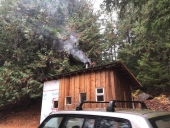





 3
3




For all your Montana Masonry Heater parts (also known as) Rocket Mass heater parts.
Visit me at
dragontechrmh.com Once you go brick you will never go back!




thomas rubino wrote:Hi Chris;
Well you got me... confused that is! I can't make heads or tails of your drawing.
As far as questions, Yes definitely insulate under your hot tub.
I would insulate the outside of your tub, not for fire hazard but to keep the water warm.
I don't follow your other questions.
Maybe you could draw a clearer picture for us?
Have you built a RMH before?
Do you have a copy of the RMH builders guide?
 5
5




 1
1




Phil Stevens wrote:Hi Chris - I don't know your whereabouts, but if you need a steel drum you can get these for free in many places. Especially jiffy lube locations. I get a couple every now and then from the local auto mechanic. All they have in them is a little bit of clean motor oil, which I carefully pour off to use as general purpose lube and rustproofing.
If you've never built an RMH before, it really pays to stick to the basics and try the simplest things first before you get into variations and experimenting. Barrel radiators are proven to be the easiest way to shed heat from the system and provide draft via densification. You'll give yourself a real advantage by keeping it simple the first time, and then getting creative once you've had a round of hands-on experience.




 3
3




For all your Montana Masonry Heater parts (also known as) Rocket Mass heater parts.
Visit me at
dragontechrmh.com Once you go brick you will never go back!







 2
2




 3
3




thomas rubino wrote:Hi Chris;
Much better drawings this time. I see what you have in mind (well sort of).
You have 9" down as your feed tube & riser size? Most are 6" or 8", A 6" is 5.5" square the 8" is 7.5" square.
To make a proper rocket you need exact dimensions from the feed tube thru the riser.
You can certainly make 9" work but you will need 9" horizontal pipes to vent it. 8" is much easier to find.
I don't see where your hot tub is in these drawings? How are you thinking the water will heat ?
Your "cooling area "? What are your thoughts about it? What is its purpose?
As Phil suggested. Any equipment/vehicle shop will have barrels. School buses, county road crew, even farmers buy bulk oil in 55 gal. drums. Oil change shops are probably the most accessible.
The draft in a RMH is produced by the hot combustion gases losing heat immediately after the heat riser. A barrel is a simple way to do this, but a masonry bell is performing the same function. Cooling gases get denser and sink. This enhances the intake draft and pushes things along in the flue.




 2
2




For all your Montana Masonry Heater parts (also known as) Rocket Mass heater parts.
Visit me at
dragontechrmh.com Once you go brick you will never go back!




 1
1




For all your Montana Masonry Heater parts (also known as) Rocket Mass heater parts.
Visit me at
dragontechrmh.com Once you go brick you will never go back!




 2
2




For all your Montana Masonry Heater parts (also known as) Rocket Mass heater parts.
Visit me at
dragontechrmh.com Once you go brick you will never go back!
 2
2




thomas rubino wrote:Sounds like your on a limited budget, but your willing to work around that. We can help.
So your cooling area already is a small bell, it could be made larger.
Or bells can be made from many materials, even cob. Large metal tanks (old fuel oil tanks) are commonly used. Bricks or cob can be added to metal tanks as available.
Or it would be massive cob work but the entire rmh could be built with clay and perlite and some scrap piping and something to form your cob into a bell.
Tell us how your hoping to build your hot tub and we may have more ideas for you to ponder.
Its possible a local library may have a copy of the RMH builders guide you could borrow or might be wiling to acquire one to have in their collection.




 1
1




For all your Montana Masonry Heater parts (also known as) Rocket Mass heater parts.
Visit me at
dragontechrmh.com Once you go brick you will never go back!
 3
3




thomas rubino wrote:Hi Chris; Yes there are parameters for sizes.
Sounds like you need to check out Peter Bergs batch rocket site, here is the link http://batchrocket.eu/en/
Peter is a master builder and freely offers all his information about bells and bell size.
Another good site is Kirk Mobert's (Donkey) here is his link http://donkey32.proboards.com/
And oh boy , I know nothing about finishing cob but... Waterproof? For a bath tub??? Hmm I'm not to sure your tub will hold up to bathing in.
What about a cob basin that you put a pond liner in? Have to figure out a way to drain it but... at least it is waterproof.
Buying building sand is the way to go. Lot to be said for #50 sacks of fireclay as well.
 1
1









 1
1





|
Anything worth doing well is worth doing poorly first. Just look at this tiny ad:
The new gardening playing cards kickstarter is now live!
https://www.kickstarter.com/projects/paulwheaton/garden-cards
|







